流体力学与传热 :1-5 Pipe Flow Systems
- 格式:ppt
- 大小:867.00 KB
- 文档页数:58
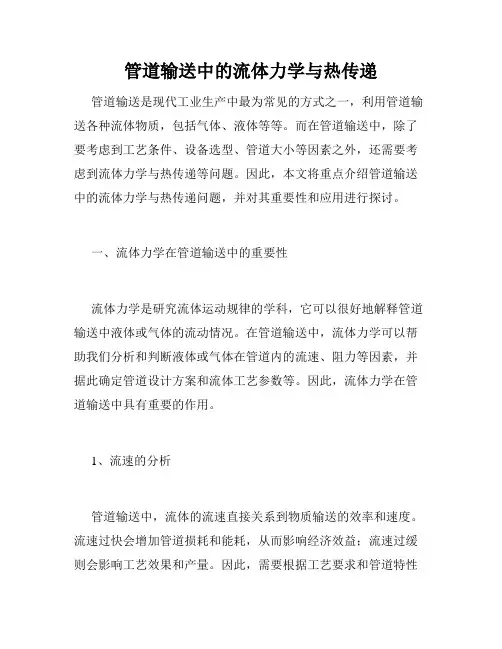
管道输送中的流体力学与热传递管道输送是现代工业生产中最为常见的方式之一,利用管道输送各种流体物质,包括气体、液体等等。
而在管道输送中,除了要考虑到工艺条件、设备选型、管道大小等因素之外,还需要考虑到流体力学与热传递等问题。
因此,本文将重点介绍管道输送中的流体力学与热传递问题,并对其重要性和应用进行探讨。
一、流体力学在管道输送中的重要性流体力学是研究流体运动规律的学科,它可以很好地解释管道输送中液体或气体的流动情况。
在管道输送中,流体力学可以帮助我们分析和判断液体或气体在管道内的流速、阻力等因素,并据此确定管道设计方案和流体工艺参数等。
因此,流体力学在管道输送中具有重要的作用。
1、流速的分析管道输送中,流体的流速直接关系到物质输送的效率和速度。
流速过快会增加管道损耗和能耗,从而影响经济效益;流速过缓则会影响工艺效果和产量。
因此,需要根据工艺要求和管道特性等因素来确定合适的流速。
流体力学分析可以帮助我们精确地计算得出流速大小,从而达到最佳的输送效果。
2、阻力的分析管道输送中,管道内壁和流体之间存在着摩擦力,这种摩擦将会对流体的流动产生阻力。
阻力大小直接关系到能耗大小,因此需要对阻力进行分析,找出减小阻力的方法。
而流体力学可以帮助我们对管道内流体的速度、黏度等因素进行分析,计算得出精确的阻力大小,为管道设计和优化提供科学依据。
3、管道结构的优化流体力学分析还可以帮助我们优化管道结构和设计。
在管道输送中,管道的长度、直径、弯头角度、内壁光滑度等因素都会影响流体流动情况。
因此,需要将这些因素纳入考虑范围,采取相应措施,优化管道结构和设计,以提高管道输送效率和经济性。
二、热传递在管道输送中的应用除了流体力学之外,热传递也是管道输送中不可缺少的一环,其重要性不亚于流体力学。
管道输送中的热传递主要表现为两种形式:传导和对流。
在管道输送过程中,热传递可以帮助我们解决流体的温度失控、物料结冻、物料沉淀、物料变质等问题。
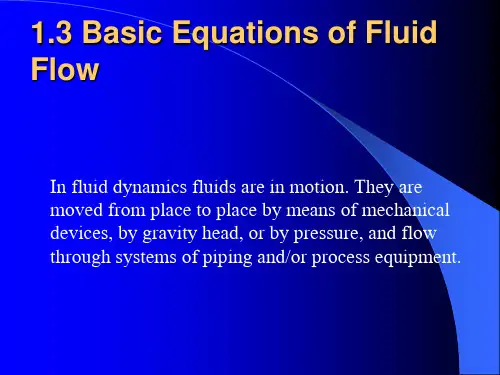
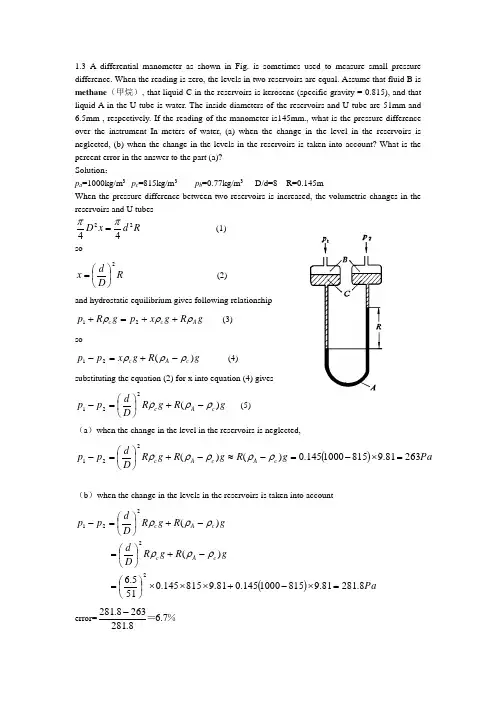
1.3 A differential manometer as shown in Fig. is sometimes used to measure small pressuredifference. When the reading is zero, the levels in two reservoirs are equal. Assume that fluid B ismethane (甲烷), that liquid C in the reservoirs is kerosene (specific gravity = 0.815), and thatliquid A in the U tube is water. The inside diameters of the reservoirs and U tube are 51mm and6.5mm , respectively. If the reading of the manometer is145mm., what is the pressure differenceover the instrument In meters of water, (a) when the change in the level in the reservoirs isneglected, (b) when the change in the levels in the reservoirs is taken into account? What is thepercent error in the answer to the part (a)?Solution :p a =1000kg/m 3 p c =815kg/m 3 p b =0.77kg/m 3 D/d=8 R=0.145mWhen the pressure difference between two reservoirs is increased, the volumetric changes in the reservoirs and U tubesR d x D 2244ππ= (1) so R D d x 2⎪⎭⎫ ⎝⎛= (2) and hydrostatic equilibrium gives following relationshipg R g x p g R p A c c ρρρ++=+21 (3)sog R g x p p c A c )(21ρρρ-+=- (4)substituting the equation (2) for x into equation (4) givesg R g R D d p p c A c )(221ρρρ-+⎪⎭⎫ ⎝⎛=- (5) (a )when the change in the level in the reservoirs is neglected,()Pa g R g R g R D d p p c A c A c 26381.98151000145.0)()(221=⨯-=-≈-+⎪⎭⎫ ⎝⎛=-ρρρρρ(b )when the change in the levels in the reservoirs is taken into account()Pa g R g R D d g R g R D d p p c A c c A c 8.28181.98151000145.081.9815145.0515.6)()(22221=⨯-+⨯⨯⨯⎪⎭⎫ ⎝⎛=-+⎪⎭⎫ ⎝⎛=-+⎪⎭⎫ ⎝⎛=-ρρρρρρ error=%=7.68.2812638.281-1.4 There are two U-tube manometers fixed on the fluid bed reactor, as shown in the figure. The readings of two U-tube manometers are R 1=400mm ,R 2=50mm, respectively. The indicating liquid is mercury. The top of the manometer is filled with the water to prevent from the mercury vapor diffusing into the air, and the height R 3=50mm. Try to calculate the pressure at point A and B .Solution: There is a gaseous mixture in the U-tube manometer meter. The densities of fluids are denoted by Hg O H g ρρρ,,2, respectively. The pressure at point A is given by hydrostatic equilibriumg R R g R g R p g Hg O H A )(32232+-+=ρρρg ρis small and negligible in comparison with Hg ρand ρH2O , equation above can be simplifiedc A p p ≈=232gR gR Hg O H ρρ+=1000×9.81×0.05+13600×9.81×0.05=7161N/m²1gR p p p Hg A D B ρ+=≈=7161+13600×9.81×0.4=60527N/mFigure for problem 1.41.5 Water discharges from the reservoir through the drainpipe, which the throat diameter is d. The ratio of D to d equals 1.25. The vertical distance h between the tank A and axis of the drainpipe is 2m. What height H from the centerline of the drainpipe to the water level in reservoir is required for drawing the water from the tank A to the throat of the pipe? Assume that fluid flow is a potential flow. The reservoir, tank A and the exit ofdrainpipe are all open to air.Solution: Bernoulli equation is written between stations 1-1 and 2-2, with station 2-2 being reference plane: 2222222111u gz p u gz p ++=++ρρ Where p 1=0, p 2=0, and u 1=0, simplification of the equation1The relationship between the velocity at outlet and velocity u o at throat can be derived by the continuity equation:22⎪⎭⎫ ⎝⎛=⎪⎪⎭⎫ ⎝⎛D d u u o 22⎪⎭⎫ ⎝⎛=d D u u o 2 Bernoulli equation is written between the throat and the station 2-23 Combining equation 1,2,and 3 gives222u Hg =222200u u p =+ρSolving for HH=1.39m1.6 A liquid with a constant density ρ kg/m 3 is flowing at an unknown velocity V 1 m/s through a horizontal pipe of cross-sectional area A 1 m 2 at a pressure p 1 N/m 2, and then it passes to a section of the pipe in which the area is reduced gradually to A 2 m 2 and the pressure is p2. Assuming no friction losses, calculate the velocities V 1 and V 2 if the pressure difference (p 1 - p 2) is measured. Solution :In Fig1.6, the flow diagram is shown with pressure taps to measure p 1 and p 2. From the mass-balance continuity equation , for constant ρ where ρ1 = ρ2 = ρ,2112A A V V = For the items in the Bernoulli equation , for a horizontal pipe,z 1=z 2=0Then Bernoulli equation becomes, after substituting 2112A A V V = for V 2, ρρ22121211212020p A A V p V ++=++ ()===144.281.92100081.910002125.11112442-⨯⨯⨯--⎪⎭⎫ ⎝⎛==ρρg h d D u HgRearranging,2)1(21212121-=-A A V p p ρ ⎥⎥⎦⎤⎢⎢⎣⎡-⎪⎪⎭⎫ ⎝⎛-12221211A A p p V ρ=Performing the same derivation but in terms of V 2,⎥⎥⎦⎤⎢⎢⎣⎡⎪⎪⎭⎫ ⎝⎛--21221212A A p p V ρ=1.7 A liquid whose coefficient of viscosity is µ flows below the critical velocity for laminar flow in a circular pipe of diameter d and with mean velocity V . Show that the pressure loss in a length of pipe L p ∆ is 232dV μ. Oil of viscosity 0.05 Pas flows through a pipe of diameter 0.1m with a average velocity of 0.6m/s. Calculate the loss of pressure in a length of 120m.Solution :The average velocity V for a cross section is found by summing up all the velocities over the cross section and dividing by the cross-sectional area1From velocity profile equation for laminar flow2 substituting equation 2 for u into equation 1 and integrating3 rearranging equation 3 gives ⎰⎰==R R rdr u R udA A V 020211ππ⎪⎪⎭⎫ ⎝⎛⎪⎭⎫ ⎝⎛--=22014R r R L p p u L μ2032D L p p V L μ-=1.8. In a vertical pipe carrying water, pressure gauges areinserted at points A and B where the pipe diameters are0.15m and 0.075m respectively. The point B is 2.5m belowA and when the flow rate down the pipe is 0.02 m 3/s, thepressure at B is 14715 N/m 2 greater than that at A.Assuming the losses in the pipe between A and B can beexpressed as g V k 22where V is the velocity at A, find the value of k . If the gauges at A and B are replaced by tubes filled with water and connected to a U-tube containing mercury of relative density 13.6, give a sketch showing how the levels in the two limbs of the U-tube differ and calculate the value of this difference in metres.Solution:d A =0.15m; d B =0.075mz A -z B =l =2.5mQ =0.02 m 3/s,p B -p A =14715 N/m 2s m d QV V d Q A A AA /132.115.0785.002.044222=⨯===ππs m d QV V d Q B B BB /529.4075.0785.002.044222=⨯===ππWhen the fluid flows down, writing mechanical balance equation222222A B B B A A A V k V g z p V g z p +++=++ρρ 213.1253.4100014715213.181.95.2222k ++=+⨯ Figure for problem 1.8 232d V L p μ=∆Pa d VL p 115201.01206.005.0323222=⨯⨯⨯==∆μk 638.0260.10715.14638.0525.24++=+=k 0.295making the static equilibriumgR g x g l p g R g x p Hg A B ρρρρρ+∆++=+∆+()()mm g g l p p R g H A B 7981.91260081.910005.214715-=⨯⨯⨯-=---=ρρρ1.9.The liquid vertically flows down through the tube from thestation a to the station b , then horizontally through the tube fromthe station c to the station d , as shown in figure. Two segments ofthe tube, both ab and cd ,have the same length, the diameter androughness.Find:(1)the expressions of g p ab ρ∆, h fab , g p cd ρ∆ and h fcd , respectively. (2)the relationship between readings R 1and R 2 in the U tube.Solution:(1) From Fanning equationandsoFluid flows from station a to station b , mechanical energy conservation giveshence2from station c to station dFigure for problem 1.922V d l h fab λ=22V d l h fcd λ=fcdfab h h =fab b a h p p +=+ρρlg fab b a h p p =+-lg ρfcd d c h p p +=ρρhence3From static equationp a -p b =R 1(ρˊ-ρ)g -l ρg 4p c -p d =R 2(ρˊ-ρ)g 5Substituting equation 4 in equation 2 ,thentherefore6Substituting equation 5 in equation 3 ,then7ThusR 1=R 21.10 Water passes through a pipe of diameter d i=0.004 m with the average velocity 0.4 m/s, as shown in Figure.1) What is the pressure drop –∆P when water flows through the pipe length L =2 m, in m H 2O column?2) Find the maximum velocity and point r at which it occurs.3) Find the point r at which the average velocityequals the local velocity. 4)if kerosene flows through this pipe ,how do thevariables above change ?(the viscosity and density of Water are 0.001 Pasand 1000 kg/m 3,respectively ;and the viscosityand density of kerosene are 0.003 Pas and 800kg/m 3,respectively )solution:1)1600001.01000004.04.0Re =⨯⨯==μρud fcd d c h p p =-ρfab h g l g R =+--'lg 1ρρρρ)(g R h fab ρρρ-'=1g R h fcd ρρρ-'=2Figure for problem 1.10from Hagen-Poiseuille equation1600004.0001.024.0323222=⨯⨯⨯==∆d uL P μ m g p h 163.081.910001600=⨯=∆=ρ 2)maximum velocity occurs at the center of pipe, from equation 1.4-19max 0.5V u = so u max =0.4×2=0.8m3)when u=V=0.4m/s Eq. 1.4-172max 1⎪⎪⎭⎫ ⎝⎛-=wr r u u 5.0004.01max2=⎪⎭⎫ ⎝⎛-u V r = m r 00284.071.0004.05.0004.0=⨯== 4) kerosene:427003.0800004.04.0Re =⨯⨯==μρud Pa p p 4800001.0003.01600=='∆='∆μμ m g p h 611.081.98004800=⨯=''∆='ρ1.12 As shown in the figure, the water level in the reservoir keeps constant. A steel drainpipe (with the inside diameter of 100mm) is connected to the bottom of the reservoir. One arm of the U-tube manometer is connected to the drainpipe at the position 15m away from the bottom of the reservoir, and the other is opened to the air, the U tube is filled with mercury and the left-side arm of the U tube above the mercury is filled with water. The distance between the upstream tap and the outlet of the pipeline is 20m.a) When the gate valve is closed, R=600mm, h=1500mm; when the gate valve is opened partly, R=400mm, h=1400mm. The friction coefficient λ is 0.025, and the loss coefficient of the entranceis 0.5. Calculate the flow rate of water when the gate valve is opened partly. (in m³/h)b) When the gate valve is widely open, calculate the static pressure at the tap (in gauge pressure, N/m²). l e /d ≈15 when the gate valve is widely open, and the friction coefficient λ is still 0.025.Solution :(1) When the gate valve is opened partially, the water discharge isSet up Bernoulli equation between the surface of reservoir 1—1’ and the section of pressure point 2—2’,and take the center of section 2—2’ as the referring plane, then ∑+++=++21,2222121122—f h p u gZ p u gZ ρρ (a ) In the equation 01=p (the gauge pressure)222/396304.181.910004.081.913600m N gh gR p O H Hg =⨯⨯-⨯⨯=-=ρρ0021=≈Z uWhen the gate valve is fully closed, the height of water level in the reservoir can be related to h (the distance between the center of pipe and the meniscus of left arm of U tube).gR h Z g Hg O H ρρ=+)(12 (b )where h=1.5mR=0.6mSubstitute the known variables into equation b 2222_1,113.22)5.01.015025.0(2)(66.65.110006.013600V V V K d l h m Z c f =+⨯=+==-⨯=∑λ Substitute the known variables equation a9.81×6.66=2213.21000396302V V ++ the velocity is V =3.13m/s Figure for problem 1.12the flow rate of water is h m V d V h /5.8813.312.0436004360032=⨯⨯⨯=⨯=ππ2) the pressure of the point where pressure is measured when the gate valve is wide-open. Write mechanical energy balance equation between the stations 1—1’ and 3-3´,then∑+++=++31,3233121122—f h p V gZ p V gZ ρρ (c ) since m Z 66.61=311300p p u Z =≈=2223_1,81.4 2]5.0)151.035(025.0[ 2)(V V V K d l l h c e f =++=++=∑λ input the above data into equation c ,9.8122V 81.4266.6+=⨯V the velocity is: V =3.51 m/sWrite mechanical energy balance equation between thestations 1—1’ and 2——2’, for the same situation of water level ∑+++=++21,2222121122—f h p V gZ p V gZ ρρ (d )since m Z 66.61=212103.51/0(page pressure Z u u m s p =≈≈=)kg J V K d l hc f /2.26251.3)5.01.015025.0(2)(222_1,=+⨯=+=∑λ input the above data into equationd , 9.81×6.66=2.261000251.322++pthe pressure is: 329702=p1.14 Water at 20℃ passes through a steel pipe with an inside diameter of 300mm and 2m long. There is a attached-pipe (Φ60⨯3.5mm) which is parallel with the main pipe. The total length including the equivalent length of all form losses of the attached-pipe is 10m. A rotameter is installed in the branch pipe. When the reading of the rotameter is2.72m 3/h, try to calculate the flow rate in the main pipe and the total flow rate, respectively. The frictional coefficient of the main pipe and the attached-pipe is 0.018 and 0.03, respectively.Solution : The variables of main pipe are denoted by a subscript 1, and branch pipe by subscript 2.The friction loss for parallel pipelines is2121S S s f f V V V h h +==∑∑The energy loss in the branch pipe is 22222222u d l l h e f ∑∑+=λ In the equation 03.02=λs m u d ml l e /343.0053.04360072.2053.01022222=⨯⨯===+∑πinput the data into equation ckg J h f /333.02343.0053.01003.022=⨯⨯=∑The energy loss in the main pipe is 333.022111121===∑∑u d l h h f f λ So s m u /36.22018.023.0333.01=⨯⨯⨯= The water discharge of main pipe is h m V h /60136.23.043600321=⨯⨯⨯=π Total water discharge ish m V h /7.60372.26013≈+=1.16 A Venturimeter is used for measuring flow of water along a pipe. The diameter of the Venturi throat is two fifths the diameter of the pipe. The inlet and throat are connected by water filled tubes to a mercury U-tube manometer. The velocity of flow along the pipe is found to be R 5.2 m/s, where R is the manometer reading in metres of mercury. Determine the loss of head between inlet and throat of the Venturi when R is 0.49m. (Relative density of mercury is 13.6). Solution: Writing mechanical energy balance equation between the inlet 1 and throat o for Venturi meterf o o hg z V p g z V p +++=++22121122ρρ 1 rearranging the equation above, and set (z 2-z 1)=xf o oh xg V V p p ++-=-22121ρ 2 from continuity equation 11221125.625V V d d V V o o =⎪⎭⎫ ⎝⎛=⎪⎪⎭⎫ ⎝⎛= 3 substituting equation 3 for V o into equation 2 gives()f f f f oh xg R h xg R h V h xg V V p p ++=++=+=++-=-94.1185.203.1903.19206.3922121211ρ 4from the hydrostatic equilibrium for manometerg x g R p p Hg o ρρρ+-=-)(1 5substituting equation 5 for pressure difference into equation 4 obtainsf Hgh xg R gx g R ++=+-94.118)(ρρρρ 6 rearranging equation 6 kg J R R R R g R h Hg f /288.267.494.11861.12394.118)(==-=--=ρρρFigure for problem 1.161.17.Sulphuric acid of specific gravity 1.3 is flowing through a pipe of 50 mm internal diameter. A thin-lipped orifice, 10mm, is fitted in the pipe and the differential pressure shown by a mercury manometer is 10cm. Assuming that the leads to the manometer are filled with the acid,calculate (a)the weight of acid flowing per second, and (b) the approximate friction loss in pressure caused by the orifice.The coefficient of the orifice may be taken as 0.61, the specific gravity of mercury as 13.6, and the density of water as 1000 kg/m 3Solution: a)2.0501010==D D =⨯-=-=-81.9)130013600(1.0)(21g R p p Hg ρρ12066.3pas kg V D m /268.0130063.201.0442220=⨯⨯⨯==πρπb) approximate pressure drop=⨯-=-=-81.9)130013600(1.0)(21g R p p Hg ρρ12066.3Pa pressure difference due to increase of velocity in passing through the orificePa D D V V V V p p o 8.44882)2.01(63.213002242412222212221=-=⎪⎪⎭⎫ ⎝⎛-=-=-ρρ pressure drop caused by friction lossPa p f 5.75778.44883.12066=-=∆2.1 Water is used to test for the performances of pump. The gauge pressure at the discharge connection is 152 kPa and the reading of vacuum gauge at the suction connection of the pump is 24.7 kPa as the flow rate is 26m 3/h. The shaft power is 2.45kw while the centrifugal pump operates at the speed of 2900r/min. If the vertical distance between the suction connection and discharge connection is 0.4m, the diameters of both the suction and discharge line are the same. Calculate the mechanical efficiency of pump and list the performance of the pump under this operating condition. ()s m p p D D C V o /63.231.461.056.1861.0130081.9)130013600(1.022.0161.021*******=⨯=≈⨯-⨯-=-⎪⎪⎭⎫ ⎝⎛-=ρSolution:Write the mechanical energy balance equation between the suction connection and discharge connection 2_1,2222121122f H gp g u Z H g p g u Z +++=+++ρρ wherem Z Z 4.012=-(Pa 1052.1(Pa 1047.22_1,215241≈=⨯=⨯-=f H u u pressure gauge p pressure gauge p ))total heads of pump is m H 41.1881.9100010247.01052.14.055=⨯⨯+⨯+= efficiency of pump is N N e /=ηsince kW g QH N e 3.1360081.9100041.18263600=⨯⨯⨯==ρ N=2.45kWThen mechanical efficiency %1.53%10045.23.1=⨯=η The performance of pump is Flow rate ,m³/h26 Total heads ,m18.41 Shaft power ,kW2.45 Efficiency ,%53.12.2 Water is transported by apump from reactor, which has200 mm Hg vacuum, to thetank, in which the gaugepressure is 0.5 kgf/cm 2, asshown in Fig. The totalequivalent length of pipe is200 m including all localfrictional loss. The pipeline isφ57×3.5 mm , the orificecoefficient of C o and orificediameter d o are 0.62 and 25mm, respectively. Frictionalcoefficient λ is 0.025. Calculate: Developed head H of pump, in m (the reading R of U pressure gauge in orifice meter is 168 mm Hg)Solution:Equation(1.6-9)Mass flow rates kg S V m o o /02.21000025.0414.312.42=⨯⨯⨯==ρ 2) Fluid flow through the pipe from the reactor to tank, the Bernoulli equation is as follows for V 1=V 2f H z gp p H +∆+-=ρ12 ∆z=10mPa p 7570710013.17602001081.95.054=⨯⨯+⨯⨯=∆ ∆p/ρg=7.7mThe relation between the hole velocity and velocity of pipeFriction losssoH=7.7+10+5.1=22.8m2.3 . A centrifugal pump is to be used to extract water from a condenser in which the vacuum is 640 mm of mercury, as shown in figure. At the rated discharge, the netpositive suction head must be at least 3m above the cavitation vaporpressure of 710mm mercury vacuum. If losses in the suction pipeaccounted for a head of 1.5m. What must be the least height of the liquid level in the condenser above the pump inlet?Solution :From an energy balance,s m Rg D d C V f /12.444.69375.062.01000)100013600(81.9168.025025162.02144000=⨯=-⨯⨯⎪⎭⎫ ⎝⎛-=-⎪⎭⎫ ⎝⎛-=ρρρ)(s m D d V V /12112.42200=⎪⎭⎫ ⎝⎛⨯=⎪⎭⎫ ⎝⎛=m g u d l f H f 1.581.92105.0200025.02422=⨯⨯==NPSH H gp p H f v o g ---=ρWhereP o =760-640=120mmHgP v =760-710=50mmHgUse of the equation will give the minimum height H g as2.4 Sulphuric acid is pumped at 3 kg/s through a 60m length of smooth 25 mm pipe. Calculate the drop in pressure. If the pressure drop falls by one half, what will the new flowrate be ?• Density of acid 1840kg/m 3• Viscosity of acid 25×10-3 PasSolution: Velocity of acid in the pipe:s m d m d mpipe of area tional cross flowrate volumetric u /32.3025.01840785.03785.04sec 222=⨯⨯===-=ρπρReynolds number:6109102532.31840025.0Re 3=⨯⨯⨯==-μρud from Fig.1.22 for a smooth pipe when Re=6109, f=0.0085 pressure drop is calculated from equation 1.4-9kg J u d l f ph f /450232.3025.0600085.042422=⨯==∆=ρ kPa p 5.8271840450=⨯=∆ or friction factor is calculated from equation1.4-25kg J u d l u d l f ph f /426232.3025.0606109046.042Re 046.042422.022.02=⨯⨯⨯==∆=--=ρkPa p 84.7831840426=⨯=∆ if the pressure drop falls to 783.84/2=391.92kPam NPSH H g p p H f v o g 55.335.181.9100081.913600)05.012.0-=--⨯⨯⨯-=---=(ρ8.18.12.12.038.12.12.022.0012.089.1079`2025.060102518401840046.042046.042Re 046.043919202u u u d l u d l p p =⎪⎭⎫ ⎝⎛⨯⨯⨯=⎪⎪⎭⎫ ⎝⎛⨯⨯⨯==∆='∆----ρμρρ= so s m u /27.236.489..1079012.03919208.18.1==⨯= new mass flowrate=0.785d 2u ρ=0.785×0.0252×2.27×1840=2.05kg/s2.4 Sulphuric acid is pumped at 3 kg/s through a 60m length of smooth 25 mm pipe. Calculate the drop in pressure. If the pressure drop falls by one half on assumption that the change of friction factor is negligible, what will the new flowrate be ?Density of acid 1840kg/m 3Viscosity of acid 25×10-3 Pa Friction factor 32.0Re500.00056.0+=f for hydraulically smooth pipe Solution: Write energy balance equation:f hg u z g p H g u z g p +++=+++2222222111ρρ gu d l g p h H f 22λρ=∆== 342=ρπu ds m d u /32.31840025.014.3124322=⨯⨯=⨯=ρπ 611510251840025.032.3Re 3=⨯⨯⨯=- 0087.061155.00056.0Re 500.00056.032.032.0=+=+=f 92.4681.9232.3025.0600087.04222=⨯⨯==∆==g u d l g p h H f λρ Δp=46.92×1840×9.81=847.0kpa2.6 The fluid is pumped through the horizontal pipe from section A to B with the φ38⨯2.5mm diameter and length of 30 meters, shown as figure. The orifice meter of 16.4mm diameter is used to measure the flow rate. Orifice coefficient C o =0.63. the permanent loss in pressure is3.5×104N/m 2, the friction coefficient λ=0.024. find:(1) What is the pressure drop along the pipe AB?(2)What is the ratio of power obliterated in pipe AB to total power supplied to the fluid when the shaft work is 500W, 60%efficiency? (The density of fluid is 870kg/m 3 )solution :∑+++=+++f A A A A AA h u p g z w u p g z 2222ρρ ρλρ022p u d l h p p f BA ∆+==-∑ 247.0334.162=⎪⎭⎫ ⎝⎛=A A o ()()s m gR C u /5.8870870136006.081.9297.063.02247.01200=-⨯⨯=''--=ρρρ ∴u = (16.4/33)2×8.5=2.1m/s∴242/76855105.321.2033.030870024.0m N h p p f B A =⨯+⨯==-∑ρ (2)W u d p Wm 1381.2033.0785.0768554Ne 22=⨯⨯⨯=∆==ρπρ sothe ratio of power obliterated in friction losses in AB to total power supplied to the fluid %%=461006.0500138⨯⨯。
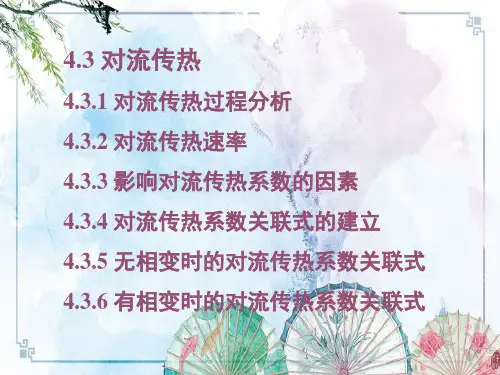
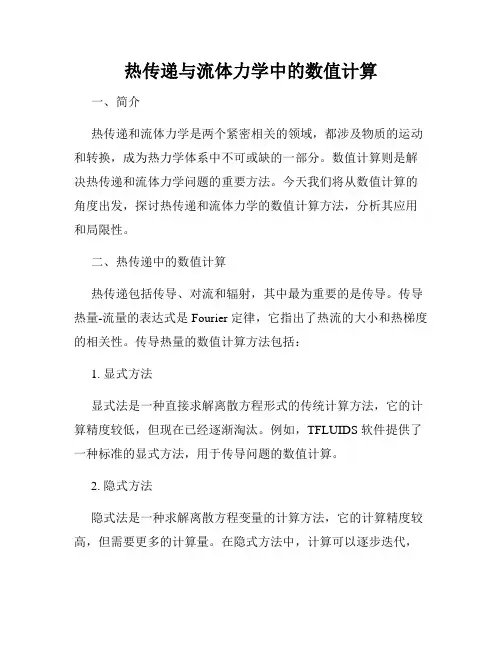
热传递与流体力学中的数值计算一、简介热传递和流体力学是两个紧密相关的领域,都涉及物质的运动和转换,成为热力学体系中不可或缺的一部分。
数值计算则是解决热传递和流体力学问题的重要方法。
今天我们将从数值计算的角度出发,探讨热传递和流体力学的数值计算方法,分析其应用和局限性。
二、热传递中的数值计算热传递包括传导、对流和辐射,其中最为重要的是传导。
传导热量-流量的表达式是 Fourier 定律,它指出了热流的大小和热梯度的相关性。
传导热量的数值计算方法包括:1. 显式方法显式法是一种直接求解离散方程形式的传统计算方法,它的计算精度较低,但现在已经逐渐淘汰。
例如,TFLUIDS 软件提供了一种标准的显式方法,用于传导问题的数值计算。
2. 隐式方法隐式法是一种求解离散方程变量的计算方法,它的计算精度较高,但需要更多的计算量。
在隐式方法中,计算可以逐步迭代,直到满足预设的精确性要求。
为了获得高精度的计算结果,通常使用数值计算软件,例如 CFD 和 ANSYS。
3. 软件仿真软件仿真是一种基于多物理场和多机构模型的高级计算方法。
它是一种计算大型和复杂热传递问题的高精度方法,可以处理各种传导模型,包括两相流、相变和复杂结构材料。
此类方法已经被广泛应用于汽车、航空航天、能源和建筑等领域的规划和设计,并得到了广泛的认可。
三、流体力学中的数值计算流体力学是液体和气体力学的研究领域,其主要研究对象是流体的运动和转换。
流体力学的主要模拟对象是流体场中的速度和压力,因此流体力学的核心是 Navier-Stokes 方程组,其中包括质量、动量和能量守恒方程。
流体力学的数值计算方法包括:1. 有限体积方法有限体积方法是一种离散流体力学方程的高精度方法,它考虑了流体的受力、耗散和粘度等因素。
有限体积方法的最大优点是可以处理高速和复杂的流体场问题,例如,超音速飞行器、汽车和火箭引擎等问题。
2. 有限元方法有限元方法是一种更为通用的计算方法,它不仅可以应用于流体力学问题,还可以应用于结构力学、热传递等其他力学问题。
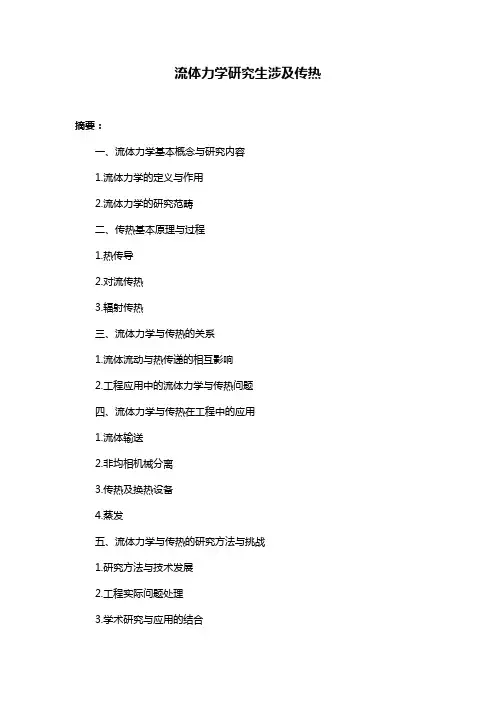
流体力学研究生涉及传热摘要:一、流体力学基本概念与研究内容1.流体力学的定义与作用2.流体力学的研究范畴二、传热基本原理与过程1.热传导2.对流传热3.辐射传热三、流体力学与传热的关系1.流体流动与热传递的相互影响2.工程应用中的流体力学与传热问题四、流体力学与传热在工程中的应用1.流体输送2.非均相机械分离3.传热及换热设备4.蒸发五、流体力学与传热的研究方法与挑战1.研究方法与技术发展2.工程实际问题处理3.学术研究与应用的结合正文:流体力学作为一门研究流体在不同条件下运动和变形的学科,广泛应用于工程技术领域。
研究生阶段对流体力学的研究,涉及到多个方向,其中传热是一个重要的研究领域。
本文将简要介绍流体力学基本概念、传热原理,以及流体力学与传热在工程中的应用和研究方法。
一、流体力学基本概念与研究内容流体力学是研究流体在不同条件下运动和变形的学科,涉及的范围包括流体静力学、流体动力学、湍流理论等。
流体力学在工程技术中具有广泛的应用,如航空航天、建筑、水利、化学工程等领域。
1.流体力学的定义与作用流体力学主要研究流体在静止和运动状态下的力学性质,包括流体的内部结构和宏观运动规律。
流体力学的作用在于揭示流体的基本规律,为工程设计和实际应用提供理论依据。
2.流体力学的研究范畴流体力学的研究范畴包括流体静力学、流体动力学、湍流理论、边界层理论、流体机械等。
在这些领域中,研究者需要探讨流体的基本性质、流动规律、力矩传递、能量转换等问题。
二、传热基本原理与过程传热是指热量从高温物体传递到低温物体的过程。
在自然界和工程应用中,传热过程普遍存在。
传热主要包括三种方式:热传导、对流传热和辐射传热。
1.热传导热传导是指热量通过固体、液体或气体等物质直接传递的过程。
热传导的速率取决于物质的导热性能和物体的厚度。
2.对流传热对流传热是指热量通过流体(如气体和液体)的运动而传递的过程。
对流传热的速率取决于流体的速度、温度梯度和流体的热导率。
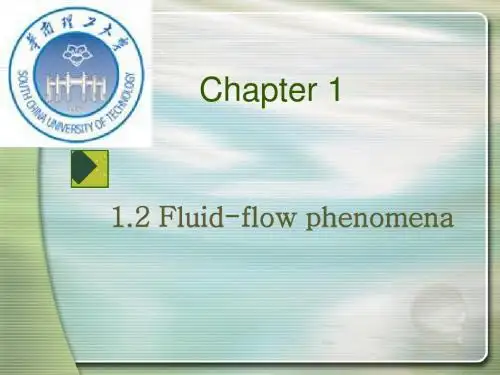
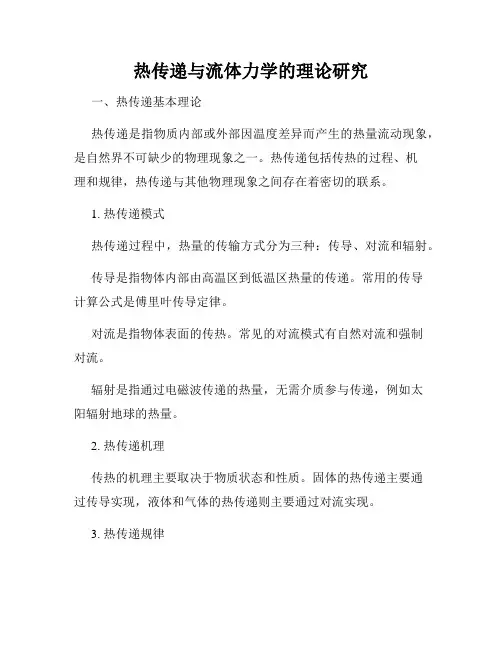
热传递与流体力学的理论研究一、热传递基本理论热传递是指物质内部或外部因温度差异而产生的热量流动现象,是自然界不可缺少的物理现象之一。
热传递包括传热的过程、机理和规律,热传递与其他物理现象之间存在着密切的联系。
1. 热传递模式热传递过程中,热量的传输方式分为三种:传导、对流和辐射。
传导是指物体内部由高温区到低温区热量的传递。
常用的传导计算公式是傅里叶传导定律。
对流是指物体表面的传热。
常见的对流模式有自然对流和强制对流。
辐射是指通过电磁波传递的热量,无需介质参与传递,例如太阳辐射地球的热量。
2. 热传递机理传热的机理主要取决于物质状态和性质。
固体的热传递主要通过传导实现,液体和气体的热传递则主要通过对流实现。
3. 热传递规律热传递中常用的物理量有流量、传热系数和传热阻力。
流量是指单位时间内热量的传递量,传热系数则是单位时间内单位温差下热源的热流密度,传热阻力是指传递热量时所经过的障碍和阻力。
4. 热传递应用热传递理论广泛应用于工业生产、温度测量和环境工程等领域。
例如,气体的热传递常常影响飞行器的设计、航空气象预报以及设备冷却等。
二、流体力学基础流体力学是一门研究流体的运动规律和性质的学科,包括流体的流动、动力学、稳定性和湍流等领域,也是应用数学的一部分。
1. 流体的基本性质流体的基本性质包括密度、压力、温度、速度和流量等。
密度时不同物质的质量与体积的比值,压力则是单位面积上垂直的力的大小。
2. 流体在静力学下的运动流体在静力学下的运动主要涉及莫门定理、贝努利定理和亚松森定理等。
通过这些定理,可以描述流体在管道、水渠和水坝等建筑物中的运动规律。
3. 流体在动力学下的运动流体在动力学下的运动主要涉及连续性方程、动量方程和能量方程等。
通过这些方程,可以描述流体在航空、航天和海洋工程等领域的运动规律。
4. 流体力学应用流体力学的应用范围非常广泛,包括航空、航天、海洋、地质、环境和工业生产等领域。
例如,在飞行器的设计和制造中,流体力学可以用来研究飞行器的空气动力学性质和热力性质。
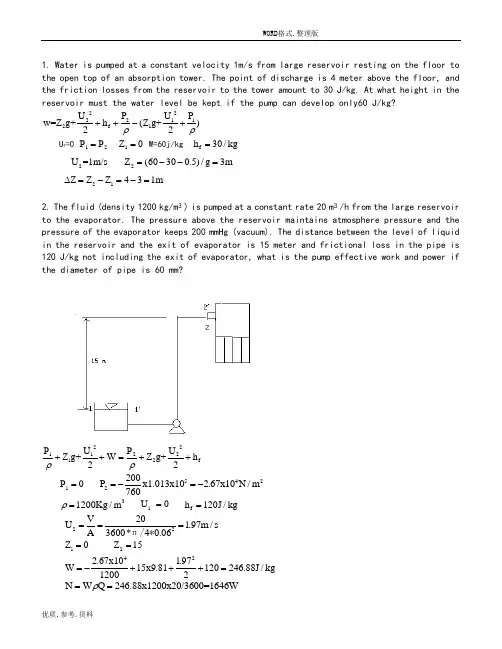
1. Water is pumped at a constant velocity 1m/s from large reservoir resting on the floor to the open top of an absorption tower. The point of discharge is 4 meter above the floor, and the friction losses from the reservoir to the tower amount to 30 J/kg. At what height in the reservoir must the water level be kept if the pump can develop only60 J/kg?2222112f 1U P U P w=Z g+h (Z g+)22ρρ++-+U 1=0 12P =P 10Z = W=60j/kg f h 30/kg =2U =1m/s 2(60300.5)/g 3m Z =--=21Z Z Z 431m ∆=-=-=2. The fluid (density 1200 kg/m 3 ) is pumped at a constant rate 20 m 3 /h from the large reservoir to the evaporator. The pressure above the reservoir maintains atmosphere pressure and the pressure of the evaporator keeps 200 mmHg (vacuum). The distance between the level of liquid in the reservoir and the exit of evaporator is 15 meter and frictional loss in the pipe is 120 J/kg not including the exit of evaporator, what is the pump effective work and power if the diameter of pipe is 60 mm?22112212f U UZ g+W Z g+h 22ρρP P ++=++10P = 5422200P x1.013x10 2.67x10N /m 760=-=- 31200Kg /m ρ= 1U 0= f h 120J /kg =22V 20U 1.97m /s A 3600*4006===π/*. 1Z 0= 2Z 15=422.67x101.97W 15x9.81120246.88J /kg 12002=-+++=N W Q 246.88x1200x20/3600=1646W ρ==3. Water comes out of the pipe (Φ108x4 mm), as shown in Fig. The friction loss of the pipeline which does not cover the loss at the exit of pipe can be calculated by the following equation: h f =6.5U 2where U is the velocity in the pipe, find a. water velocity at section A-A'. b. water flow rate, in m 3 /h.22112212f U UZ g+Z g+h 22ρρP P +=++ 1U0= 12P =P 1Z 6m = 2Z 0=2f h 6.5U = 22U 6x9.81 6.5U 2=+U 2.9m/s = 23V=UA=2.94x01x360082m /h =π/.4. Water passes through the variable pipe. The velocity in the small pipe is 2.5 m/s. The vertical glass tubes are inserted respectively at the section A and B to measure the pressure (see fig.) If the friction loss between two section is 15 J/kg, what is the water column difference between two glass tubes? By the way, draw the relative liquid column height of two tubes in the Fig.a ab b U A U A = 2b U 2.5*(33/47)1.23m /s ==22aa b b a b f U U Z g+Z g+h 22ρρP P +=++ a b Z =Z22abb a f U U h 22ρρP P -=-+221.23/2 2.5/21512.63=-+= a b P P R g ρ-=∆ 3312.63R=1.29x10m 9.8x10-∆=5. A centrifugal pump takes brine (density 1180 kg/m 3 , viscosity 1.2 cp) from the bottom of a supply tank and delivers it into another tank. The line between the tanks is 300 m of 25 mm diameter pipe (inner diameter). The flow rate is 2 m 3 /h. In this line, there are two gate valves, four elbows (90o ) and one return bend, what is the friction loss if the roughness of pipe is 0.025 mm?22f fst flocal U U h h h 4f k d 22l ∑=+=+∑31180kg /m ρ= 300m, d=0.025m l =3-3v 2m /h =1.2cp=1.2x10Pa.s μ= k=0.025mm k/d=0.025/25=0.001 c l r k =0.4 k =1 k =2x0.07=0.14 el re k 4x0.75 3 k 1.5-2.2===2u v /A 2/(3600x /4x0.025)1.13m /s π===4u d Re 2.78x10ρμ== f 0.063=2f 2h 4x0.0063x300/0.025x1.13/2+(0.4+1+2x0.07+4x0.7+1.5)x1.13/2 =197.86J/kg∑=6. The orifice meter (diameter of orifice 0.0001 m) is installed for measuring the flow rate. The indicating liquid of orifice is mercury if U shape pressure gauge reading is 0.6 meterand orifice coefficient can be taken as 0.61, what is the flow rate of water?o u c =20o 0V u s 0.61x /4x0.0001π==835.8x10m /s -=7. Water flows through a pipe with a diameter di 100 mm as shown in figure.a. when the valve is closed, R is 600 mm and h equals 1500 mm. While the valve opens partially, R=400 mm and h=1400 mm, f=0.00625 (Finning factor) and k c =0.5 (contraction coefficient), what is the flow rate of water, in m 3 /h?b. If the valve opens fully, what is the pressure of section 2-2', in N/m 2 ? The equivalentlength of the valve is 1.5 m and the Fanning factor f keeps the same?(ρH2O =1000kg/m 3,ρHg =13600kg/m 3)(1) the valve opens partially ,for selection 1-1’ and 2-2’ , we have22112212f 1-2u u gZ gZ h 22ρρP P ++=+++ 2212Hg H o 0 g(R h)39630N/m ρρP =P =-= 2212f1-2c u u u 0 Z =0 h 4f +k 2.13ud 22===lWe can get Z1 from the valve closed21Hg H O h=1.5m R=0.6m Z gR/h 6.66m ρρ=-=229.81x6.66u /2 2.13u 39630/1000=++23h u=3.13m/s V 3600x /4x0.1x3.1388.5m /h π==(2) when the valve opens fully, for section 1-1’ and 3-3’, we have22331113f1-3u u gZ gZ h 22ρρP P ++=+++ 311Z 0 Z 6.66m u =0==22e f1-3c u 3.1.5h (4f k )(4x0.00625x +0.5) 4.81u d 20.01l l ++=+== 229.81x6.66u /2 4.81u =+ u 3.51m/s =For section 1-1’ and 2-2’22112212f1-2u u gZ gZ h 22ρρP P ++=+++112120 Z 6.66 Z 0 u 0 u 3.51P =====22f1-2c l u h (4f k )(4x0.00625x15/0.10.5)3.51/226.2J /kg d 2=+=+= 22229.81x6.66 3.15/226.2N32970mρP=++P =8. The rotameter is installed to measure the water flow rate, as shown in figure. If the total length including equivalent length of pipeline A is 10 m and the reading of rotameter is 2.72 m 3 /h, what is the flow rate for pipeline B? (f A =0.0075, f B =0.0045)For parallel pipe linefA fB total A B22A fAA 2A h h V V +V u (l+le) 2.72h 4f 4x0.0075x10/0.053/2()d 23600x /4x0.053π∑=∑=∑∑== 0.333J /kg =22B fB B B B 23B B B B u (l+le)h 4f 4x0.0045x2/0.3/2xu 0.333d 2u 2.36m /s V =u A 2.36x /4x0.23600m /hπ∑∑======10. A flat furnace wall is constructed of 120 mm layer of sil-o-cel brick, with a thermal conductivity 0.08 w/(m o C), backed by a 150 mm of common brick, of conductivity 0.8 w/(m o C), the temperature of inner face of the wall is 1400 o , and that of the outer face is 200o C. a. What is the heat loss through the wall in w per square meter.b. To reduce the heat loss to 600 w/m 2 by adding a layer of cork with k 0.2 w/(m o C) on the outside of common brick, how many meters of cork are requied?a. 2Q t 1400200711N /m 11L R 0.080.80.120.15∑∆-===∑+b. 600=(1400-200)/(0.12/0.08+0.15/0.8+x/0.2) x=0.0625m13. Air at the normal pressure passes through the pipe (d i 20 mm) and is heated from 20o C to 100o C. What is the film heat transfer coefficient between the air and pipe wall if the average velocity of air is 10 m/s? The properties of air at 60 o C are as follows:density 1.06 kg/m 3 , viscosity 0.02 cp, conductivity 0.0289 w/(m o C), and heat capacity 1kJ/kg-K443u d 10x0.02x1.06 Re=1.06x10100.02x10ρμ-==> 12T +T 20100T=6022+==℃ 0.141ωμμ⎛⎫= ⎪⎝⎭10000.020.0010.6920.0289p c x x k μ==Pr=()()0.81/3081/34Nu 0027Re Pr 0.027x 1.06x10x 0.69239.66==.=.()2i i i h d 39.66 h 39.66x0.0289/0.02=57.22w/m .k k==14. A hot fluid with a mass flow rate 2250 kg/h passes through a ∅25x2.5 mm tube. The physical properties of fluid are as follows:k=0.5 w/(m o C), C p =4 kJ/kg-K, viscosity 10-3 N-s/m 2 , density 1000 kg/m 3 Find: a. Heat transfer film coefficient h i , in w/(m 2 -K).b. If the flow rate decreases to 1125 kg/h and other conditions are the same, what is the h i ?c. If the diameter of tube (inside diameter) decreases to 10 mm, and the velocity u keeps the same as that of case a, calculate h i .d. When the average temperature of fluid and quantity of heat flow per meter of tube are 40 o C and 400 w/m, respectively, what is the average temperature of pipe wall for case a?e. From this problem, in order to increase the heat transfer film coefficient and enhance heat transfer, what kinds of methods can you use and which is better, explain? Hint: for laminar flow, Nu=1.86[Re Pr]1/3 for turbulent flow Nu=0.023Re 0.8 Pr 1/3(1) 444N 2250x4u d Gd d 3600x x0.02Re 3.98x10100.001ρππμμμ=====>()()1/30.8081/3424Nu 0023Re Pr 0.023x 3.98x10220.10.5Nuk 220.1x0.5hi 5500w /m k d 0.02⎛⎫== ⎪⎝⎭===.=.(2) 12w 2w = 4421Re Re /2=2x1010=>0.80.82211Nu Re 0.5Nu Re ⎛⎫== ⎪⎝⎭0.8i2i1h 0.5h = ()0.82i2h 5500x0.53159w /m k ==(3) 44333u d 2000x0.01Re 2x10100.001ρμ===>0.81/3Nu 0.023RePr = ()2hi=6347w/m k(4)i i w w Q=h A (t-t )=400=500x2x0.02(t-t )πw t=40t 39.41=℃ ℃(5) there methods : increase u or hi or decrease d The first is better15. In a double pipe exchange (Φ23x2 mm), the cold fluid (Cp=1 kJ/kg, flow rate 500 kg/h) passes through the pipe and the hot fluid goes through the outside. The inlet and outlet temperatures of cold fluid are 20 and 80 o , and the inlet and outlet temperatures of hot fluid are 150 and 90o , respectively. The h i (film coefficient inside pipe) is 700 w/(m 2 o C)and overall heat transfer coefficient U o (based on the outside surface of pipe) is 300w/(m 2 o C), respectively. If the heat loss is ignored and the conductivity of pipe wall (steel) is taken as 45 w/(m o C), find:(1) heat transfer film coefficient outside the pipe h o ? (2) the pipe length required for counter flow, in m?(3) what is the pipe length required if the heating medium changes to saturated vapor(140 o C) and it condenses to saturated liquid and other conditions keep unchanged? (4) When the exchanger is used for a year, it is found that it cannot meet the need of production (the outlet temperature of cold fluid cannot reach 80 o C), explain why?(a) 0m o 0i i m d l d 111230.002x23h Vo h d kd 300700x1945x21⎛⎫=-+=-- ⎪⎝⎭ 1/h0=1/U0-(do/hidi+bdo/kdm)=1/300-23/700*19-0.002*23/45*21 ()20h 642.9w/m k = 12t +t LMTD=702∆∆℃=Q=UoAo ∆Tm=mcCp(Tcb-Tca) 300*2π*0.023*70L=500/3600*1000*(80-20)L=5.4m(c) 8020LMTD=86.514020ln14080-=--℃1122L t70/86.5L t ∆==∆ 2L 0.81L1 4.4m ==(d) scale is formed on the outside ,V 0 is decreased16. Water flows turbulently in the pipe of Φ25x2.5 mm shell tube exchanger. When the velocity of water u is 1 m/s, overall heat transfer coefficient Uo (based on the outer surface areaof pipe) is 2115 w/(m 2o C). If the u becomes 1.5 m/s and other conditions keep unchanged, Uois 2660 w/( m 2o C ). What is the film coefficient ho outside the pipe? (Heat resistances of pipe wall and scale are ignored) o i h h Uo 111+= (1) oi o h h U 1'1'1+= (2) (1)-(2)=0.80.80.80.81211111121152660u C u C 1C 1.5C-=-=-C=2859io h Uo h 111-= ho=8127W/(m2K)17. Water and oil pass parallelly through an exchanger which is 1 m long. The inlet and outlet temperatures of water are 15 and 40 o C, and those of oil are 150 and 100 o C, respectively. If the outlet temperature of oil decreases to 80 o C, and the flow rates and physical properties and inlet temperatures of water and oil maintain the same, what is the pipe length of new exchanger? (Heat loss and pipe wall resistance are neglected)()()h h 12c c 21m Q W C T -T W C t t VA t ==-=∆()()h h 12c c 21W C T -T 'W C t 't =-2150100401515080t 15--=-- 2t 50=℃212m1112m2L T T 't 1508092.51.85L T T t 15010069.8-∆-===-∆- 2m1m2L 1.85m L1=1m t 92.5 t 69.8=∆=∆=18. Air which passes through the pipe in turbulent flow is heated from 20 to 80 o C. The saturatedvapor at 116.3 o C condenses to saturated water outside the pipe. If air flow rate increases to 120% of the origin and inlet and outlet temperatures of air stay constant, what kind of method can you employ in order to do that? (Heat resistance of pipe wall and scale can be ignored))(111ca cb pc c m i i T T C m T A h -=∆=1Q)'(2212ca cb pc c m i T T C m T A h -=∆=2Q 128.012112i22.12.1h m m c c m i m T T m m T h T ∆∆===∆∆ )803.116/()203.116ln(20801---=∆m T)80/()20ln(20802---=∆h h m T T TTh=118.5oC19. Water flows through the pipe of a Φ25x2.5 mm shell-tube exchanger from 20 to 50 o C. The hot fluid (C p 1.9 kJ/kg o C, flow rate 1.25 kg/s) goes along the shell and the temperatureschange from 80 to 30 o C. Film coefficients of water and hot fluid are 0.85kw/(m 2o C) and 1.7kw/(m 2o C). What is the overall heat transfer coefficient Uo and heat transfer area if the scale resistance can be ignored? (the conductivity of steel is 45w/(m o C).W=1.25Kg/s Cp=1.9Kj/kg ℃()()2h p 12Q W C T T 1.25x1.9x 80-30119Kw =-==m 3010t 30ln10-∆= ()200m 00i i m 1V 472w/m k d l d 1h h d kd ++==32i 0m Q 119x10A 13.9m V t 472x18.2===∆20. A spherical particle (density 2650 kg/m 3) settles freely in air at 20 o C (density of air 1.205 kg/m 3 , viscosity 1x10-5 Pa.s). Calculate the maximum diameter of particle if the settle obeys the Stoke s’ Law?Re ≤1 ()2p t p D g U 18D ρρμμρP -==()23p 18D g μρρρP =- ()1/3-10p 18x10D 1.205x9.81x 2650-1.205⎛⎫= ⎪ ⎪⎝⎭=3.85x10-521. A filter press(A=0.1 m 2 ) is used for filtering slurry. The vacuum inside the filter is 500 mm Hg. One liter filtrate can be got after filtering of 5 min and 0.6 more liter filtrate is obtained after 5 more min. How much filtrate will be got after filtering of 5 more min?for filter press 22e V 2VV =KA θ+5 min 22e 12V 0.1x5K +=(1) 10min 22e 1.62x1.6V 0.1x10K +=(2)From (1) (2),we can see Ve=0.7 K=4815 min 22V 2x0.7V=48x0.1x15+ V=2.07m 3/h22. The following data are obtained for a filter press (A=0.0093 m 2) in a lab.------------------------------------------------------------------------------------------------pressure difference (kg f /cm 2 ) filtering time (s) filtrate volume (m 3 )1.05 502.27⨯10-3 660 9.10⨯10-33.50 17.1 2.27⨯10-3 233 9.10⨯10-3 Find1) filtering constant K, q e , t e at pressure difference 1.05 kg f /cm 2 ?2) if the frame of filter is filled with the cake at 660 s, what is the end filtering rate (dV/dt)E at P 1.05 kg f /cm 2 ?3) compressible constant of cake s?For p=1.05Kg/cm 22e 2e 2e q 2qq K 0.002270.0002272x q 50K 0.00930.000930.000910.000912x q 660K 0.000930.00093θ+=⎛⎫+= ⎪⎝⎭⎛⎫+= ⎪⎝⎭We can see K=0.015 qe=0.026For p=3.5Kg/cm21-s K=2k ∆P 1-s K'=2k '∆P1sK 'K '-∆P ⎛⎫= ⎪∆P ⎝⎭ ()2E eV KA 2V+V d d θ⎛⎫=⎪⎝⎭23. A slurry is filtered by a 0.1 m 2 filter press at constant pressure if the cake is incompressible. The filter basic equation is as follows: (q+10)2 = 250(t+ 0.4) where q---l/m 2 t----minfind (1) how much filtrate is got after 249.6 min?(2) if the pressure difference is double and the resistance of cake is constant, how much filtrate can be obtained after 249.6 min? (cake is imcompressible)(1)let θ=249.6 ()()2q+10250x 249.60.4=+ q=240 V=qA=240*0.1=24 (2) K 2k =∆P K'2k '=∆P '2∆P =∆P K'2K 500== ()()2q'+10500x 249.60.4=+ q ’=343.6 v=34.36。

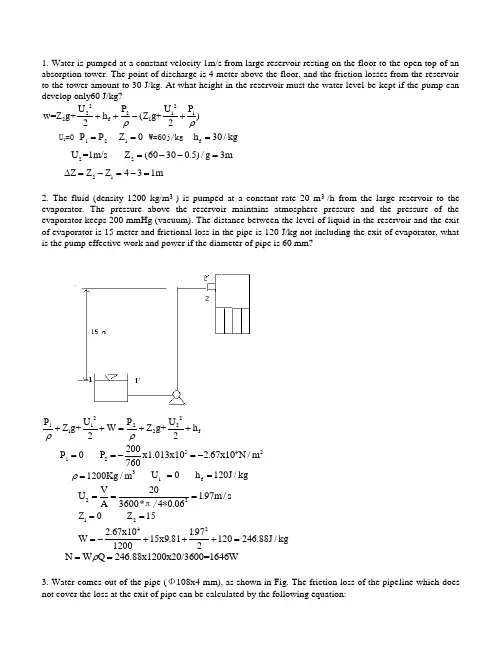
1. Water is pumped at a constant velocity 1m/s from large reservoir resting on the floor to the open top of an absorption tower. The point of discharge is 4 meter above the floor, and the friction losses from the reservoir to the tower amount to 30 J/kg. At what height in the reservoir must the water level be kept if the pump can develop only60 J/kg?2222112f 1U P U P w=Z g+h (Z g+)22ρρ++-+ U 1=0 12P =P 10Z = W=60j/kg f h 30/kg =2U =1m/s 2(60300.5)/g 3m Z =--=21Z Z Z 431m ∆=-=-=2. The fluid (density 1200 kg/m 3 ) is pumped at a constant rate 20 m 3 /h from the large reservoir to the evaporator. The pressure above the reservoir maintains atmosphere pressure and the pressure of the evaporator keeps 200 mmHg (vacuum). The distance between the level of liquid in the reservoir and the exit of evaporator is 15 meter and frictional loss in the pipe is 120 J/kg not including the exit of evaporator, what is the pump effective work and power if the diameter of pipe is 60 mm?22112212f U U Z g+W Z g+h 22ρρP P ++=++ 10P = 5422200P x1.013x10 2.67x10N /m 760=-=- 31200Kg /m ρ= 1U 0= f h 120J /kg =22V 20U 1.97m /s A 3600*4006===π/*. 1Z 0= 2Z 15= 422.67x101.97W 15x9.81120246.88J /kg 12002=-+++= N W Q 246.88x1200x20/3600=1646W ρ==3. Water comes out of the pipe (Φ108x4 mm), as shown in Fig. The friction loss of the pipeline which does not cover the loss at the exit of pipe can be calculated by the following equation:h f =6.5U 2where U is the velocity in the pipe, finda. water velocity at section A-A'.b. water flow rate, in m 3 /h. 22112212f U U Z g+Z g+h 22ρρP P +=++ 1U 0= 12P =P 1Z 6m = 2Z 0=2f h 6.5U = 22U 6x9.81 6.5U 2=+ U 2.9m/s = 23V=UA=2.94x01x360082m /h =π/.4. Water passes through the variable pipe. The velocity in the small pipe is 2.5 m/s. The vertical glass tubes are inserted respectively at the section A and B to measure the pressure (see fig.) If the friction loss between two section is 15 J/kg, what is the water column difference between two glass tubes? By the way, draw the relative liquid column height of two tubes in the Fig.a ab b U A U A = 2b U 2.5*(33/47)1.23m /s == 22a a b b a b f U U Z g+Z g+h 22ρρP P +=++ a b Z =Z 22a b b a f U U h 22ρρP P -=-+221.23/2 2.5/21512.63=-+= a b P P R g ρ-=∆ 3312.63R=1.29x10m 9.8x10-∆=5. A centrifugal pump takes brine (density 1180 kg/m 3 , viscosity 1.2 cp) from the bottom of a supply tankand delivers it into another tank. The line between the tanks is 300 m of 25 mm diameter pipe (inner diameter). The flow rate is 2 m 3 /h. In this line, there are two gate valves, four elbows (90o ) and one return bend, what is the friction loss if the roughness of pipe is 0.025 mm?22f fst flocal U U h h h 4f k d 22l ∑=+=+∑ 31180kg /m ρ= 300m, d=0.025m l =3-3v 2m /h =1.2cp=1.2x10Pa.s μ=k=0.025mm k/d=0.025/25=0.001c l r k =0.4 k =1 k =2x0.07=0.14el re k 4x0.75 3 k 1.5-2.2===2u v /A 2/(3600x /4x0.025)1.13m /s π===4u d Re 2.78x10ρμ== f 0.063= 2f 2h 4x0.0063x300/0.025x1.13/2+(0.4+1+2x0.07+4x0.7+1.5)x1.13/2 =197.86J/kg∑=6. The orifice meter (diameter of orifice 0.0001 m) is installed for measuring the flow rate. The indicating liquid of orifice is mercury if U shape pressure gauge reading is 0.6 meter and orifice coefficient can be takenas 0.61, what is the flow rate of water?o u c =20o 0V u s 0.61x /4x0.0001π==835.8x10m /s -=7. Water flows through a pipe with a diameter di 100 mm as shown in figure.a. when the valve is closed, R is 600 mm and h equals 1500 mm. While the valve opens partially, R=400 mm and h=1400 mm, f=0.00625 (Finning factor) and k c =0.5 (contraction coefficient), what is the flow rate of water, in m 3 /h?b. If the valve opens fully, what is the pressure of section 2-2', in N/m 2 ? The equivalent length of the valve is1.5 m and the Fanning factor f keeps the same?(ρH2O =1000kg/m 3, ρHg =13600kg/m 3)(1) the valve opens partially ,for selection 1-1’ and 2-2’ , we have 22112212f 1-2u u gZ gZ h 22ρρP P ++=+++ 2212Hg H o 0 g(R h)39630N/m ρρP =P =-= 2212f1-2c u u u 0 Z =0 h 4f +k 2.13u d 22===l We can get Z1 from the valve closed21Hg H O h=1.5m R=0.6m Z gR/h 6.66m ρρ=-=229.81x6.66u /2 2.13u 39630/1000=++23h u=3.13m/s V 3600x /4x0.1x3.1388.5m /h π==(2) when the valve opens fully, for section 1-1’ and 3-3’, we have 22331113f1-3u u gZ gZ h 22ρρP P ++=+++ 311Z 0 Z 6.66m u =0== 22e f1-3c u 3.1.5h (4f k )(4x0.00625x +0.5) 4.81u d 20.01l l ++=+== 229.81x6.66u /2 4.81u =+ u 3.51m/s =For section 1-1’ and 2-2’22112212f1-2u u gZ gZ h 22ρρP P ++=+++ 112120 Z 6.66 Z 0 u 0 u 3.51P ===== 22f1-2c l u h (4f k )(4x0.00625x15/0.10.5)3.51/226.2J /kg d 2=+=+= 22229.81x6.66 3.15/226.2N 32970mρP =++P =8. The rotameter is installed to measure the water flow rate, as shown in figure. If the total length including equivalent length of pipeline A is 10 m and the reading of rotameter is 2.72 m 3 /h, what is the flow rate for pipeline B? (f A =0.0075, f B =0.0045)For parallel pipe line fA fB total A B22A fA A 2A h h V V +V u (l+le) 2.72h 4f 4x0.0075x10/0.053/2()d 23600x /4x0.053π∑=∑=∑∑== 0.333J /kg = 22B fB B B B 23B B B B u (l+le)h 4f 4x0.0045x2/0.3/2xu 0.333d 2u 2.36m /s V =u A 2.36x /4x0.23600m /h π∑∑======10. A flat furnace wall is constructed of 120 mm layer of sil-o-cel brick, with a thermal conductivity 0.08 w/(m o C), backed by a 150 mm of common brick, of conductivity 0.8 w/(m o C), the temperature of inner face of the wall is 1400 o , and that of the outer face is 200o C.a. What is the heat loss through the wall in w per square meter.b. To reduce the heat loss to 600 w/m 2 by adding a layer of cork with k 0.2 w/(m o C) on the outside of common brick, how many meters of cork are requied? a. 2Q t 1400200711N /m 11L R 0.080.80.120.15∑∆-===∑+ b. 600=(1400-200)/(0.12/0.08+0.15/0.8+x/0.2)x=0.0625m13. Air at the normal pressure passes through the pipe (d i 20 mm) and is heated from 20o C to 100o C. What is the film heat transfer coefficient between the air and pipe wall if the average velocity of air is 10 m/s? The properties of air at 60 o C are as follows:density 1.06 kg/m 3 , viscosity 0.02 cp, conductivity 0.0289 w/(m o C), and heat capacity 1 kJ/kg-K443u d 10x0.02x1.06 Re=1.06x10100.02x10ρμ-==>12T +T 20100T=6022+==℃ 0.141ωμμ⎛⎫= ⎪⎝⎭10000.020.0010.6920.0289p c x x k μ==Pr= ()()0.81/3081/34Nu 0027Re Pr 0.027x 1.06x10x 0.69239.66==.=. ()2i i i h d 39.66 h 39.66x0.0289/0.02=57.22w/m .k k ==14. A hot fluid with a mass flow rate 2250 kg/h passes through a ∅25x2.5 mm tube. The physical properties of fluid are as follows:k=0.5 w/(m o C), C p =4 kJ/kg-K, viscosity 10-3 N-s/m 2 , density 1000 kg/m 3 Find:a. Heat transfer film coefficient h i , in w/(m 2 -K).b. If the flow rate decreases to 1125 kg/h and other conditions are the same, what is the h i ?c. If the diameter of tube (inside diameter) decreases to 10 mm, and the velocity u keeps the same as that of case a, calculate h i .d. When the average temperature of fluid and quantity of heat flow per meter of tube are 40 o C and 400 w/m, respectively, what is the average temperature of pipe wall for case a?e. From this problem, in order to increase the heat transfer film coefficient and enhance heat transfer, what kinds of methods can you use and which is better, explain?Hint: for laminar flow, Nu=1.86[Re Pr]1/3for turbulent flow Nu=0.023Re 0.8 Pr 1/3 (1) 444N 2250x4u d Gd d 3600x x0.02Re 3.98x10100.001ρππμμμ=====> ()()1/30.8081/3424Nu 0023Re Pr 0.023x 3.98x10220.10.5Nuk 220.1x0.5hi 5500w /m k d 0.02⎛⎫== ⎪⎝⎭===.=. (2) 12w 2w = 4421Re Re /2=2x1010=> 0.80.82211Nu Re 0.5Nu Re ⎛⎫== ⎪⎝⎭ 0.8i2i1h 0.5h = ()0.82i2h 5500x0.53159w /m k == (3) 44333u d 2000x0.01Re 2x10100.001ρμ===> 0.81/3Nu 0.023Re Pr = ()2hi=6347w/m k(4)i i w w Q=h A (t-t )=400=500x2x0.02(t-t )πw t=40t 39.41=℃ ℃(5) there methods : increase u or hi or decrease dThe first is better15. In a double pipe exchange (Φ23x2 mm), the cold fluid (Cp=1 kJ/kg, flow rate 500 kg/h) passes throughthe pipe and the hot fluid goes through the outside. The inlet and outlet temperatures of cold fluid are 20 and 80 o , and the inlet and outlet temperatures of hot fluid are 150 and 90o , respectively. The h i (film coefficient inside pipe) is 700 w/(m 2 o C)and overall heat transfer coefficient U o (based on the outside surface of pipe) is 300w/(m 2 o C), respectively. If the heat loss is ignored and the conductivity of pipe wall (steel) is taken as 45 w/(m o C), find:(1) heat transfer film coefficient outside the pipe h o ?(2) the pipe length required for counter flow, in m?(3) what is the pipe length required if the heating medium changes to saturated vapor(140 o C) and it condenses to saturated liquid and other conditions keep unchanged?(4) When the exchanger is used for a year, it is found that it cannot meet the need of production (the outlet temperature of cold fluid cannot reach 80 o C), explain why? (a) 0m o 0i i m d l d 111230.002x23h Vo h d kd 300700x1945x21⎛⎫=-+=-- ⎪⎝⎭ 1/h0=1/U0-(do/hidi+bdo/kdm)=1/300-23/700*19-0.002*23/45*21()20h 642.9w/m k =12t +t LMTD=702∆∆℃= Q=UoAo ∆Tm=mcCp(Tcb-Tca) 300*2π*0.023*70L=500/3600*1000*(80-20)L=5.4m(c) 8020LMTD=86.514020ln 14080-=--℃ 1122L t 70/86.5L t ∆==∆ 2L 0.81L1 4.4m == (d) scale is formed on the outside ,V 0 is decreased16. Water flows turbulently in the pipe of Φ25x2.5 mm shell tube exchanger. When the velocity of water u is 1 m/s, overall heat transfer coefficient Uo (based on the outer surface area of pipe) is 2115 w/(m 2 o C). If the u becomes 1.5 m/s and other conditions keep unchanged, Uo is 2660 w/( m 2 o C ). What is the film coefficient ho outside the pipe? (Heat resistances of pipe wall and scale are ignored)o i h h Uo 111+= (1) oi o h h U 1'1'1+= (2) (1)-(2)= 0.80.80.80.81211111121152660u C u C 1C 1.5C-=-=- C=2859 io h Uo h 111-= ho=8127W/(m2K)17. Water and oil pass parallelly through an exchanger which is 1 m long. The inlet and outlet temperatures of water are 15 and 40 o C, and those of oil are 150 and 100 o C, respectively. If the outlet temperature of oil decreases to 80 o C, and the flow rates and physical properties and inlet temperatures of water and oil maintain the same, what is the pipe length of new exchanger? (Heat loss and pipe wall resistance are neglected) ()()h h 12c c 21m Q W C T -T W C t t VA t ==-=∆()()h h 12c c 21W C T -T 'W C t 't =-2150100401515080t 15--=-- 2t 50=℃ 212m1112m2L T T 't 1508092.51.85L T T t 15010069.8-∆-===-∆- 2m1m2L 1.85m L1=1m t 92.5 t 69.8=∆=∆=18. Air which passes through the pipe in turbulent flow is heated from 20 to 80 o C. The saturated vapor at 116.3 o C condenses to saturated water outside the pipe. If air flow rate increases to 120% of the origin and inlet and outlet temperatures of air stay constant, what kind of method can you employ in order to do that? (Heat resistance of pipe wall and scale can be ignored))(111ca cb pc c m i i T T C m T A h -=∆=1Q)'(2212ca cb pc c m i T T C m T A h -=∆=2Q 128.012112i22.12.1h m m c c m i m T T m m T h T ∆∆===∆∆ )803.116/()203.116ln(20801---=∆m T )80/()20ln(20802---=∆h h m T T T Th=118.5oC19. Water flows through the pipe of a Φ25x2.5 mm shell-tube exchanger from 20 to 50 o C. The hot fluid (C p1.9 kJ/kg o C, flow rate 1.25 kg/s) goes along the shell and the temperatures change from 80 to 30 o C. Film coefficients of water and hot fluid are 0.85kw/(m 2 o C) and 1.7 kw/(m 2 o C). What is the overall heat transfer coefficient Uo and heat transfer area if the scale resistance can be ignored? (the conductivity of steel is 45w/(m o C).W=1.25Kg/s Cp=1.9Kj/kg ℃()()2h p 12Q W C T T 1.25x1.9x 80-30119Kw =-==m 3010t 30ln 10-∆= ()200m 00i i m 1V 472w/m k d l d 1h h d kd ++==32i 0m Q 119x10A 13.9m V t 472x18.2===∆20. A spherical particle (density 2650 kg/m 3) settles freely in air at 20 o C (density of air 1.205 kg/m 3 , viscosity 1x10-5 Pa.s). Calculate the maximum diameter of particle if the settle obeys the Stoke s’ Law?Re ≤1 ()2p t p D g U 18D ρρμμρP -== ()23p 18D g μρρρP =- ()1/3-10p 18x10D 1.205x9.81x 2650-1.205⎛⎫= ⎪ ⎪⎝⎭=3.85x10-521. A filter press(A=0.1 m 2 ) is used for filtering slurry. The vacuum inside the filter is 500 mm Hg. One liter filtrate can be got after filtering of 5 min and 0.6 more liter filtrate is obtained after 5 more min. How much filtrate will be got after filtering of 5 more min?for filter press 22e V 2VV =KA θ+5 min 22e 12V 0.1x5K +=(1)10min 22e 1.62x1.6V 0.1x10K +=(2)From (1) (2),we can see Ve=0.7 K=4815 min 22V 2x0.7V=48x0.1x15+ V=2.07m 3/h22. The following data are obtained for a filter press (A=0.0093 m 2) in a lab.------------------------------------------------------------------------------------------------pressure difference (kg f /cm 2 ) filtering time (s) filtrate volume (m 3 )1.05 502.27⨯10-3660 9.10⨯10-33.50 17.1 2.27⨯10-3233 9.10⨯10-3Find1) filtering constant K, q e , t e at pressure difference 1.05 kg f /cm 2 ?2) if the frame of filter is filled with the cake at 660 s, what is the end filtering rate (dV/dt)E at P 1.05 kg f /cm 2 ?3) compressible constant of cake s?For p=1.05Kg/cm 22e 2e 2e q 2qq K 0.002270.0002272x q 50K 0.00930.000930.000910.000912x q 660K 0.000930.00093θ+=⎛⎫+= ⎪⎝⎭⎛⎫+= ⎪⎝⎭We can see K=0.015 qe=0.026For p=3.5Kg/cm 21-s K=2k ∆P 1-s K'=2k '∆P 1s K 'K '-∆P ⎛⎫= ⎪∆P ⎝⎭ ()2E e V KA 2V+V d d θ⎛⎫= ⎪⎝⎭23. A slurry is filtered by a 0.1 m 2 filter press at constant pressure if the cake is incompressible. The filter basic equation is as follows:(q+10)2 = 250(t+ 0.4)where q---l/m 2 t----minfind (1) how much filtrate is got after 249.6 min?(2) if the pressure difference is double and the resistance of cake is constant, how much filtrate can be obtained after 249.6 min? (cake is imcompressible)(1)let θ=249.6 ()()2q+10250x 249.60.4=+ q=240 V=qA=240*0.1=24(2) K 2k =∆P K'2k '=∆P'2∆P =∆P K'2K 500== ()()2q'+10500x 249.60.4=+ q ’=343.6 v=34.36。
绪论知识点聚焦单元操作——指在化工生产过程中普遍使用的、遵循一定的物理学定律、所用设备相似、具有类似作用的物理操作,简称单元操作。
引入单元操作概念可以将化工生产过程分成单元操作过程与化学反应过程两部分研究,从而缩短化工产品的研发周期。
三传——包括:动量传递、热量传递和质量传递。
流体输送、过滤等在外力作用下进行的单元操作过程,由牛顿第二定律可知是涉及动量传递的过程;对象加热、汽化、冷却、冷凝等单元操作过程属于因温度差导致的热量传递过程;对于吸收、蒸馏、萃取、吸附等单元操作属于因浓度差导致的相际质量传递过程。
“三传”过程往往是同时进行并相互影响,如水的蒸发过程涉及传热与传质过程。
三传类似性——“三传”之间存在一定的类似性,如过程进行的方向都是从高(动量、能量、温度、浓度)到低;三传过程的阻力均集中于某一区域;过程速率均可表达为过程推动力除以阻力的形式等等。
单位与单位制——单位是衡量物理量的大小的依据,有基本单位和导出单位之分。
基本单位与导出单位的集合则称为单位制(度)。
由于不同时期对研究的需要和出发点的不同,先后有不同的单位制。
由于国际单位制(SI)有“通用性”与“一贯性”两大优点,所以我国目前使用的法定单位制是以国际单位制为基础并结合国情增添了必要的辅助单位及词冠而构成的。
流体——具有流动性质的物体,包括气体和液体。
液体的密度随压强的变化可忽略,故称为不可压缩流体;气体的密度随压强有明显的变化,故称为可压缩流体。
无流动阻力的流体称为理想流体;满足牛顿粘性定律的流体称为牛顿型流体;实际流体多为非牛顿型流体。
系统——工程上指研究的对象,是指定研究的某个区域范围。
稳定流动系统与不稳定流动系统的概念——稳定流动系统又称定态或定常流动系统,是指流动系统中各物理量的大小仅随位置变化的系统,也即在指定截面上物理量的值恒为常数的流动系统。
若流动系统中各物理量不仅随位置变化且随时间变化的,则称为不稳定流动系统,又称非定态或非定常流动系统。
传热与流体力学的相互作用研究与应用引言传热和流体力学是研究物质内部的能量传递和流动行为的两个重要学科。
它们在自然界和工程领域中都有广泛的应用。
传热与流体力学的相互作用是两个学科交叉的领域,具有重要的理论研究和应用价值。
本文将介绍传热与流体力学的基本概念及其相互作用的研究进展,并探讨其在不同领域的应用。
传热的基本概念传热是热量从高温物体传递到低温物体的过程。
热量的传递有三种方式:导热、对流和辐射。
导热是通过物质内部的分子热运动进行热量传递,它的主要方式是热传导。
对流是通过流体的运动进行热量传递,它的主要方式是强迫对流和自然对流。
辐射是通过电磁波辐射进行热量传递。
传热的研究内容包括传热机理、传热模型和传热传质的耦合。
流体力学的基本概念流体力学研究物质流动的规律和性质。
流体力学主要分为两个方面:流体静力学和流体动力学。
流体静力学研究静止的流体,并研究其受力平衡的问题。
流体动力学研究流体的运动,包括流体的速度、压力和密度等变化规律。
流体力学的研究内容包括流体的本构关系、能量方程和动量方程等。
传热与流体力学的相互作用传热与流体力学相互作用的研究是传热与流体力学学科交叉的领域。
它研究在流体中传热过程中热量传递与流体流动之间的相互影响。
传热对流体流动产生的影响主要包括:热源对流体流动的推动作用、热传导对流体流动的抑制作用和热辐射对流体流动的影响。
流体流动对传热的影响主要包括:流体流动对热传导的增强作用、流体流动对传热界面的清洗作用和流体流动对热辐射的干扰作用。
传热与流体力学的相互作用是一个复杂的问题,需要通过实验和数值模拟来研究。
传热与流体力学的应用传热与流体力学的相互作用在工程领域有着广泛的应用。
以下是几个应用的例子:1. 热交换器热交换器是传热与流体力学相互作用的典型应用。
热交换器通过流体的对流传热来实现热量的转移。
流体在热交换器内部流动时,会与热交换器壁面进行热传递,从而实现热量的平衡。
热交换器的设计和优化需要考虑传热与流体力学的相互作用,以提高传热效率和节约能源。
流体力学中的流动与传热耦合引言流体力学是研究流体运动规律的科学,而传热是指热量从一个物体传递到另一个物体的过程。
在许多实际应用中,流体力学和传热是密切关联的,两者之间存在着耦合关系。
本文将探讨流体力学中流动与传热的耦合问题,包括热传递的基本原理、耦合方程的建立以及数值模拟方法。
热传递的基本原理热传递是指热能从高温区域传递到低温区域的过程,其基本原理可归纳为三种传热方式:导热、对流和辐射。
导热导热是指热能通过物质内部的分子传递的过程。
根据傅里叶热传导定律,导热速率正比于温度梯度。
在流体力学中,热传导的数学模型可以表示为:$$ \\mathbf{q} = -k\\cdot \ abla T $$其中,$\\mathbf{q}$为热流密度,k为热导率,ablaT为温度梯度。
这个方程描述了流体中的热传导过程。
对流对流是指热能通过流体的流动传递的过程。
对流传热由于流体的运动而产生。
在流体力学中,对流传热的数学模型可以表示为:$$ \\mathbf{q} = h\\cdot (T-T_f) $$其中,$\\mathbf{q}$为热流密度,ℎ为对流换热系数,T为物体表面的温度,T f为流体的温度。
这个方程描述了流体中的对流传热过程。
辐射辐射是指热能通过电磁波的辐射传递的过程。
辐射传热不需要介质的存在,可以在真空中传递。
在流体力学中,辐射传热的数学模型可以表示为:$$ \\mathbf{q} = \\sigma\\cdot\\epsilon\\cdot (T^4-T_f^4) $$其中,$\\mathbf{q}$为热流密度,$\\sigma$为斯特藩-玻尔兹曼常数,$\\epsilon$为辐射率,T为物体表面的温度,T f为流体的温度。
这个方程描述了流体中的辐射传热过程。
耦合方程的建立在流体力学中,流动和传热是密切关联的,两者之间存在耦合关系。
当流体中存在温度梯度时,热量会通过流动而传递。
同样地,当流体中存在流动时,流体颗粒之间的热量也会通过对流传递。
http://202.114.88.54/new/clgcjc/web/第五节流体的输送设备----风机5.1风机的基本结构与工作原理5.2风机的性能参数和性能曲线5.3离心式风机性能参数换算5.4风机的工作点和流量调节5.5离心式风机的并联和串联操作http://202.114.88.54/new/clgcjc/web/风机是给被输送的流体提供能量的设备。
目前均已系列化。
5.1 风机的基本结构与工作原理(1)风机的种类①按用途分通风机、鼓风机、压缩机、真空机等;②按结构分叶片式风机、叶轮式风机、罗茨式风机(容积式)。
http://202.114.88.54/new/clgcjc/web/(2)离心式风机的基本结构1-吸入口;2-叶轮前盘;3-叶片;4-后盘;5-机壳;6-出口;7-截流板,即风舌;8-支架http://202.114.88.54/new/clgcjc/web/(3)工作原理叶轮随转轴旋转时,充满于叶片之间的气体,在离心力的作用下,从叶轮中心甩向叶轮周围,挤入机壳,机壳内的气体压强增高,最后被导向出口排出。
叶片间的气体被甩出后,叶轮中心部分的压强降低。
外界气体从吸入口通过叶轮前盘中央的孔口吸入,再源源不断地输送出。
http://202.114.88.54/new/clgcjc/web/ 5.2 风机的性能参数和性能曲线5.2.1 性能参数风机的主要性能参数有:流量、压头、功率、效率和转速(1) 流量Q:单位时间内风机所输送的流体量,常用体积流量表示,单位为m3/s或m3/h。
(2) 压头P:单位体积流体流经风机时获得的有效能量,单位为Pa。
http://202.114.88.54/new/clgcjc/web/(3) 功率N和效率η轴功率N:由电动机输入风机轴的功率,单位W或kW。
(4) 转速n风机叶轮每分钟的转数即“r/min”,或rpm 。
效率η:反映能量损失大小的参数称为效率。